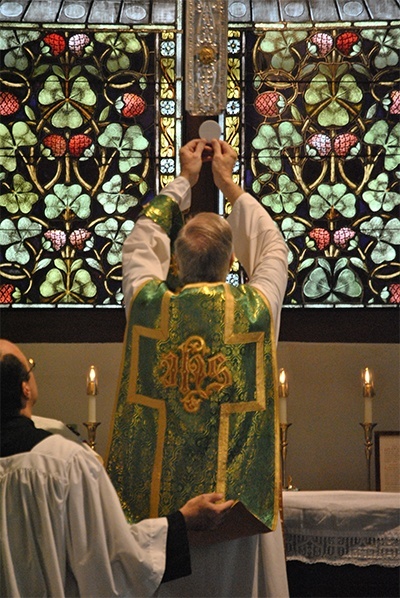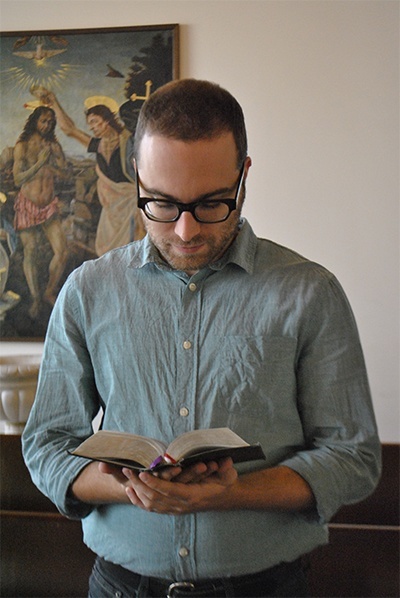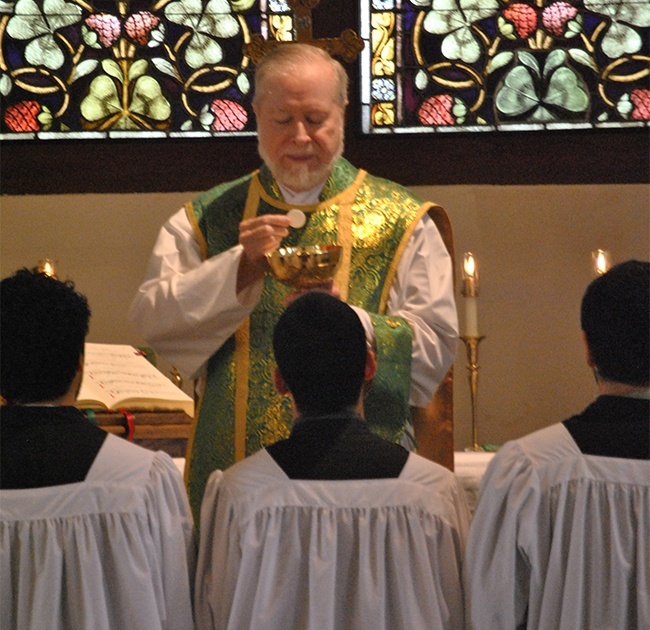By Blanca Morales - Florida Catholic

Photographer: BLANCA MORALES| FC
Father Joseph Fishwick elevates the host during consecration. In the Extraordinary Form of the Mass, the priest faces ad orientem ("to the East") in the same direction as the rest of the congregation: toward God. The posture of the community is not oriented toward the priest, because Mass is considered a conversation with God, not the celebrant.
Raised to be anti-Catholic, Hernandez began to look for a Christian denomination with historical relevance and formal liturgical practice. Though he thought Catholicism seemed too ritualistic, his first stop in his search for a church was attending a Mass to �get it out of the way.�
�It all clicked,� he said, when he saw the Latin Mass �in all its glory.�
Now he is a regular attendee at the Extraordinary Form Latin Mass celebrated each Sunday at 9 a.m. at Sts. Francis and Clare Mission in Edgewater.
Likewise, his girlfriend, Vida Tavakoli, knew she had found her home in the Catholic Church when she first attended Latin Mass in England.
Formerly an atheist, her aversion toward religion changed at the end of her college career, when she became a Protestant. During her post-collegiate travels she became resolute in converting to Catholicism after attending a Missa Cantata, or sung Mass, in the parish of her favorite author, J.R.R. Tolkien, a devout Catholic who penned the �Lord of the Rings� series.
- Aside from Sundays, those interested in celebrating the Extraordinary Form of the Latin Mass are welcome to attend Sts. Francis and Clare Mission on:
- Thursday, July 25 at 7 p.m. for the feast of St. James; and
- Gesu Church on Thursday, Aug. 15 at 7 p.m. for the feast of the Assumption.
- Sts. Francis and Clare is located at 402 N.E. 29 St., Miami; Gesu is located at 118 N.E. Second St., Miami.
- Mass in the Extraordinary Form is also celebrated in Broward:
- At St. Malachy Parish, 6200 N. University Drive, Tamarac, the first and last Sundays of the month at 7:30 a.m.; and
- at St. Paul the Apostle, 2700 N.E. 36 St., Lighthouse Point, the first and third Sundays of the month at 1:30 p.m.
When she heard Latin hymns coming from the choir loft, Tavakoli said, it felt like �hearing angels on high.�
She was mesmerized. �It truly is extraordinary,� she said. �There is something beautiful and sacred about this form of the Mass.�
Many of those in attendance each Sunday at Sts. Francis and Clare are, in fact, young adults like Hernandez and Tavakoli, younger Catholics who did not grow up attending Mass in Latin. Their attendance is part of a national trend, as the number of Masses offered in the Extraordinary Form in the U.S. rose from approximately 60 in 1991 to just over 400 in 2010.
Miami�s traditional Latin Mass community has been served by Father Joseph Fishwick for 600 consecutive Sundays over the past 17 years. Father Fishwick, who grew up in South Florida and attended the University of Miami, remembers attending Mass as a child when the Tridentine Rite was the norm.

Photographer: BLANCA MORALES| FC
Antonio De Gaetano uses his 1962 missal during Mass. The Latin Mass community provides a missal which follows the liturgy in Latin and provides an English translation, with explanation of the rubrics of the Mass.
Today, priests interested in celebrating the Latin Mass often learn the Extraordinary Form on their own. Though most seminaries focus on teaching the novus ordo, many are beginning to host workshops for those interested in the Extraordinary Form.
Last year, Archbishop Thomas Wenski invited the Priestly Fraternity of Saint Peter (FSSP), whose charism focuses on preserving and imparting the spiritual heritage of the traditional liturgy, to teach archdiocesan priests about the Mass of Blessed John XXIII.
After 38 years of priesthood, Father Fishwick is retiring this August, and will be succeeded as the community�s chaplain by Msgr. Oscar F. Casta�eda, spiritual director at St. John Vianney College Seminary in Miami. He will be assisted by Father Rafael Cap�, director of the Southeast Pastoral Institute (SEPI) in Miami.
The schola, or choir, at Sts. Francis and Clare is directed by Jennifer Donelson, a young adult and assistant professor at Nova Southeastern University, where she directs the Nova Bossa Chorale and teaches various subjects in music.
Donelson, who has led the schola since 2008, describes the dedication of those involved as heroic, because all come from different parts of Miami-Dade and Broward counties.
The schola has significantly flourished since Donnelson, together with a colleague, began the annual Musica Sacra Gregorian Chant Conference, which is now in its sixth year.
The schola �enjoys the privilege of glorifying God and sanctifying the faithful through our dedication to singing the Mass in truly sacred music, music from the heart of the Church,� Donelson said. �Gregorian chant �grew up� with the Roman rite, and it is an integral part of the structure and mystagogy of the Mass.�
Paulina Pecic, a student at the University of Miami who attends St. Augustine parish in Coral Gables, recently attended her first Latin Mass while visiting Ave Maria University on Florida�s southwest coast.
�It was beautiful,� she said, hoping for another �chance to embrace the extra beauty that the chanting might offer.�
Fellow UM student and Archbishop Coleman Carroll High alumnus Ryan Stacey, who attended Latin Mass for this first time this summer, noted that it was unique experience, especially since he did not learn or attend Latin Mass while in high school.
The Traditional Latin Mass, alternately referred to as the Tridentine Mass, the Mass of John XIII, usus antiquior, or the Extraordinary Form, has fallen out of use following the Second Vatican Council due to revisions in the Missal.
In recent years, the Extraordinary Form of the Mass has gained popularity among those born in the generations that followed Vatican II. Traditional Latin Mass in the United States has seen a steady rise in recent years. The number of Masses offered in the Extraordinary Form rose from approximately 60 in 1991 to just over 400 in 2010.
Pope-emeritus Benedict XVI, in his motu proprio, Summorum Pontificum, an apostolic letter published in 2007, noted that, �Immediately following the Second Vatican Council, it might have been imagined that the demand for the use of the 1962 Missal would have been limited to older generations, which had grown up with it, but it has since become clear that young people were also discovering this liturgical form, feeling attracted to it and finding in it a type of contact with the Most Holy Eucharist which suited them particularly well.�
In Summorum Pontificum, Pope Benedict XVI specified that priests no longer required special permission from their bishops to celebrate the Extraordinary Form.
He also stated: �There is no contradiction between the two editions of the Roman Missal� The two Forms of the usage of the Roman Rite can be mutually enriching� What earlier generations held as sacred, remains sacred and great for us too�It behooves all of us to preserve the riches which have developed in the Church�s faith and prayer, and to give them their proper place.�
For that reason, the young adults of the forthcoming Juventutem Miami chapter seek to propagate their love and enthusiasm for the Extraordinary Form of the Mass, so that others can come to know and appreciate it.
Pecic said she appreciated the �reverential aspect that can sometimes be watered down, or, in a worst-case scenario, completely disregarded by the congregation during the Ordinary Form.�
�I especially enjoyed Communion (at traditional Latin Mass), where instead of going up to the priest, the priest comes to you at the kneeler,� she said. �It was a visible reminder for me that receiving Christ in the Eucharist is a gift given out of love and not a right to claim for granted.�
As to which form of the Mass she likes better, she said, �It�s like comparing apples and oranges. I think both the Ordinary and the Extraordinary are beautiful in their own ways. The Ordinary Form makes the Mass accessible to every person in the Body of Christ by means of comprehensive, yet still profound language, whereas the more mysterious Extraordinary Form inspires awe by drawing us into contemplation of the very mysteries of the Word Himself.�
See related story: Dogma on Draft

Photographer: BLANCA MORALES| FC
Father Joseph Fishwick distributes Communion to altar servers. As an act of reverence, Communion is received kneeling, on the tongue.


Comments from readers
The Latin replies, the Kyrie and Gloria, I still knew them all by heart. Communion was at the rail on the tongue and there was no singing or bongo drums, just lovely organ music. I could actually do my Eucharistic devotion in peace! I was hooked!
The following week I joined the parish. I found there were families that drove 50 miles one way to Mass each week. Young families with lots of children, middle aged couples, the elderly, people from all walks of life who wanted a more reverent, quiet, and beauty filled liturgy fill this small inner city parish each Sunday at 11 a.m.
I am so glad I decided to attend that Christmas Midnight Mass!
In the Catholic Church the study of Latin received a boost when Pope Paul VI established a foundation called Latinitas for the study and promotion of Latin. Recently Latinitas was absorbed by the newly founded Academy of Latin that came into existence under Benedict XVI. For decades young people have been participating every year at the Vatican in musical, theatrical, and literary exhibitions using the Church's language and awards were granted for poetry and prose written in Latin. A quarterly called Latinitas is published entirely in Latin.
Pope John Paul II wrote letters of encouragement on various occasions to the participants of Latinitas, saying for example: �be aware, young people, that the Successor of Peter is praying for your success, that he is close to you, that he strengthens you.� (Acta Apostolicae Sedis 71 pp. 44-46)
One might note that the new Code of Canon Law (can. 249) stipulates that young men studying for priesthood must learn Latin well. The �ordinary form� of the Roman Rite (Novus Ordo) is also considered a Latin liturgy in its standard (typical) form.
Finally, no one is trying to undermine people's desire to use the languages that are familiar to them, but that does not mean that the study of the Latin must be completely abandoned.